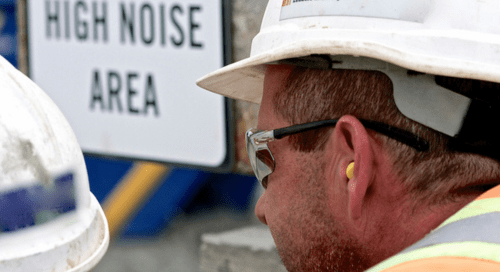#AvoidNoise - how to prevent hearing loss in the workplace

Results from a Statistics Canada health study offer disturbing findings regarding adult hearing loss.*Could you or your co-workers be among the 1 in 5 adults aged 19 to 79 who have mild hearing loss or more in at least one ear? Here's another: most people with measured hearing loss were unaware they had any hearing problems. Chances are, with time and continued exposure the problem will get worse
Protect the hearing of everyone in your workplace, including yourself, by leveraging International Noise Awareness Day in April. WSPS Specialized Consultant (Occupational Hygiene) Warren Clements offers eight suggestions below. But first, here are a few facts about noise exposure and hearing.
Forty-two percent of Canadians aged 16 to 79 have worked or currently work in an environment where communicating to someone an arm's length away requires speaking in a raised voice. "That's a noisy work environment," says Warren. Among these individuals, 22% said they always use hearing protection while 39% said they never do. The remaining percentage said they sometimes, often, or rarely, use hearing protection.
Noise exposure cuts across all industries. Furthermore, says Warren, all noise sources count, whether you're at work, home or play. If you're working with tools around the house, cutting wood with a chainsaw, or hunting with firearms, they too could contribute to your overall noise exposure.
Because hearing loss is a gradual process, continues Warren, many people may not realize their hearing is at risk until it's too late. The resulting hearing loss can have severe emotional and social consequences, including social isolation, depression, limited mobility, and reduced income and employment opportunities. It can even put people at greater risk of injury if they can't hear back-up alarms and other warning sounds.
How to Leverage International Noise Awareness Day
Here are eight ways to raise awareness about noise in your workplace.
- Set up a noise control display.
- Schedule hearing loss prevention training and education, including hazards of noise exposure, audiometric testing, and proper use of hearing protection on and off the job.
- Invite senior management on a noise-related inspection and discuss noise control options after
- Make a public commitment to maintaining your hearing, at work and at home. Invite others to join you.
- Conduct an informal employee survey.
- If your workplace has a hearing loss prevention program in place, also promote some aspect of the program.
- Update your noise exposure assessment. If you have not had a formal exposure assessment, start with an informal JHSC-partnered employee survey.
- Announce hearing loss prevention program updates, achivements and new initiatives.
How to know if your workplace may need a noise control program
Ask yourself and a sampling of employees the following questions.
- Do I need to raise my voice while I'm in the workplace?
- Do I have ringing in my ears?
- On my way home from work, do I need to increase the volume of my radio or digital music player higher than what it was on my way to work?
- When I'm in a noisy environment with competing noises (e.g., a restaurant or a social gathering). is it difficult to hear other people?
If you and the people you survey answer yes to these questions, look into conducting a more formal assessment.
How WSPS can help
Connect with an occupational hygiene consultant to help you carry out noise assessments or build your hearing loss prevention program.
Training
- Preventing Hearing Loss from Workplace Noise (1 hour, eCourse)
Articles
- 8 best practices to prevent noise-induced hearing loss at work
- Noise apps: what you need to know
- Why we need to be more noise aware
- Noise-induced hearing loss is preventable
- Teleworking: 7 ways to reduce noise and improve well-being
- Protect workers from chemical-related hearing loss with these 4 best practices
* Source: Hearing loss of Canadians, 2012 and 2013, a report on the Canadian Health Measures Survey (CHMS). The survey collects information through a household interview and direct physical measures at a mobile clinic.




